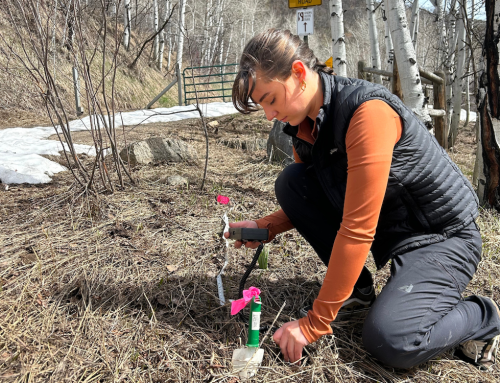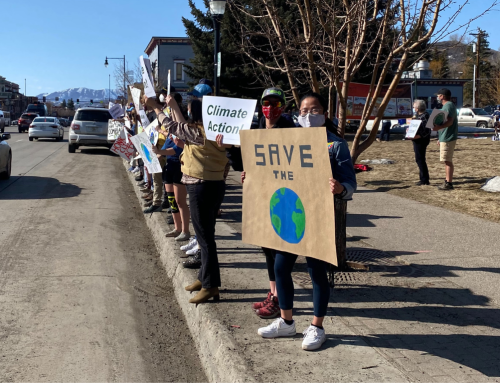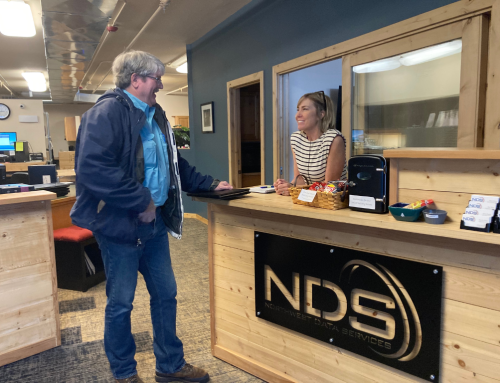SEPTEMBER 14, 2018 BY
Adopted from Steamboat Pilot Today Article
STEAMBOAT SPRINGS— Smoky skies and continued growth of the Silver Creek Fire have been the narrative of a long, dry summer in Routt County.
As of Friday, Aug. 31, the fire had burned a total of 4,772 acres. But this phenomenon isn’t exclusive to Northwest Colorado.
Dr. Heidi Stelzer, an expert in botany and snowmelt from Fort Lewis College, called Colorado a “tinder box waiting for a spark” at the beginning of the year, and those sparks seemed to take flight in June.
“By June’s end, Colorado was home to the largest number of active wildfires in the country,” Stelzer said in a telephone news conference with Environmental Colorado about climate change and wildfires. “We saw over 200,000 acres of our historic rangelands, mountain meadows and forests burned. Ranch and farmhouses were destroyed by fire, and livelihoods were lost.”
Wildfires, to an extent, are a natural part of a forest’s ecosystem. Trees like the lodgepole pine have serotinous cones, which open in the presence of heat and spread seeds for reproduction.
But the danger lies when the frequency and duration of wildfires increase in areas of Colorado that don’t usually burn, and when they’re not low-intensity surface fires, but severe crown fires in the canopies.
Stelzer contends that climate change is a major factor in the severity of Colorado wildfires.
Silver Creek Fire
What started as a 12- to 15-acre wildfire on July 20 grew to 4,772 acres as of Aug. 31 in the Sarvis Creek Wilderness Area of the Medicine Bow-Routt National Forest.
The Silver Creek Fire started from near the top of Gore Mountain and made its way to the area of Latigo Ranch and Old Park in Grand County.
“In general, the Routt National Forest doesn’t have a lot of whole lot of wildfires — it’s not a fire-prone unit,” said Aaron Voos, U.S. Forest Service public affairs specialist. “This year, due to the size, very specifically of the Silver Creek Fire, it’s going to make it one of the larger fire years for the Routt National Forest.
“Since 1970, this is definitely one of our larger fire years, but it’s not because we’ve had multiple starts,” Voss explained. “It’s because we had one big fire.”
Like 2016, when the Beaver Creek Fire burned more than 38,000 acres, the Silver Creek Fire has been the only large-scale fire in Routt National Forest this summer, but it has done its damage.
By contrast, the 2002 fire season was a year of multiple fires, Voss said.
The trend in the Routt National Forest is that fires are burning longer, which is partially due to their locations deep in the wilderness — in terrain that is dangerous for firefighters to reach.
“It started in wilderness, which often lends itself to a little bit of an indirect suppression approach,” Voos said. “Sometimes, we can just wait for it to do its thing in wilderness and then come out and engage it at that point. We knew by the time it got out of wilderness, it would build up some steam.”
As of Friday, Aug. 31, the Silver Creek Fire is 52 percent contained.
Voos said there are a variety of factors that allowed the fire to gain traction with the main one being the abundance of fuels, like trees that fell victim to mountain pine beetles in the early 2000s, making it unsafe for firefighters to engage.
On a larger scale, climate change also plays into what makes a wildfire season longer and detrimental to Colorado forests.
Climate and its impact on fuels
Snowpack, summer precipitation and temperature are all key weather factors that define the Colorado climate. These can help mitigate a fire season.
Measurements for Steamboat Ski Area’s snowpack show that the 2017-18 season was a low year at 263 inches, but not the lowest.
“For a bad year, Steamboat was the best of the worst,” said Jim Pokrandt, director of community affairs at the Colorado River District. “When you went further down to Gunnison Basin, San Juan Basin, those folks were down in the 40 to 60 percent median snowpack.”
Less snow and the timing of when it melts can create a drier environment. If the snow melts earlier, the ground dries up faster, which can extend the fire season.
“Since the 1950s, snowpack across Colorado has decreased by at least 20 percent at the statewide monitoring sites,” Stelzer said. “That same decline in snowpack can be seen at the state ski resorts. Over the next 50 years, we expect to see a further 10 to 60 percent decline in snowpack.
“With shorter, more chaotic winters, we’re seeing snow melt earlier, snow melt faster,” Stelzer said. “It’s harder to manage for water, and the earth gets left very dry. When the ground is dry, rains run off and over the land rather than into the land.”
But according to a recent study by the University of Montana published in the “Proceedings of the National Academy of Science,” it’s the decline in summer precipitation that is the main driver of a dry season.
As of Aug. 22, Steamboat had 11.03 inches of precipitation, which made for a hot and dry summer.
These conditions create a prime environment for fuels, which is forest debris that helps spread fire. In Routt National Forest, mountain pine or spruce beetles attacked distressed trees during times of drought.
Standing dead trees are not as much of a threat as those that have fallen to the forest floor, which can carry fire through a “ladder effect” to the canopies. But if standing trees still contain dead needles, which turn red when they die, they are more likely to be ignited.
Temperatures can affect the cyclical life cycles of beetles, allowing second generations of infestations in warmer summer and fall seasons.
Mountain pine beetles have been the most detrimental to Routt’s forests, but a spruce beetle outbreak killed many trees in the north central area of the Zirkels in 2002.
Beetle-killed trees aren’t the only source of fuel in Routt National Forest, there are also plants like sagebrush and gambel oak that are closer to the ground, which can dry up and ignite.
According to Dr. Deborah Kennard, an expert in fire ecology from Colorado Mesa University, in higher elevation forests, it can take over a month for surface fuels, like vegetation, to fully dry out, whereas lower elevation forests of ponderosa pine need less than a day.
Long-term effects of increased temperature and decreased precipitation will have a more telling impact in places like Routt National Forest, which are not used to burning as frequently.
Scientists said it’s important to study long-term temperature and precipitation fluctuations rather than year-to-year assessments. For example, in 2016, the Beaver Creek Fire in Routt County burned more than 38,000 acres.
Pokrandt notes that it’s the overall drier period over the past few decades that has made a difference in the landscape. One year of good precipitation won’t make up for years of decreased precipitation.
According to an article published in the Forest Ecology and Management journal in 2014, average temperatures are projected to increase every season by 3 degrees Fahrenheit in the summer and 2 to 3.5 degrees in the fall, which will heighten drought occurrences.
Fires in an era of climate change
Warming is occurring because of the human burning of fossil fuels, which release carbon dioxide and other gases into the atmosphere. Energy from the sun hits the earth, changes its wavelength, and as it heads back to space, gases absorb the energy, warming the planet.
Plants, like trees in the Colorado forests, are able to take in carbon dioxide to make sugar and release oxygen through photosynthesis.
“But like a bank account, there needs to be a balance, and for over a century, our green world hasn’t been able to keep up with our fossil fuel burning,” Stelzer said. “Forests are fantastic carbon savings accounts, especially when they are healthy. When they are not healthy, they are less able to store carbon for us, and when they are burning, they are the equivalent of power plants loading the carbon dioxide into the atmosphere.”
When forests burn more frequently in areas that would take longer to recover, it can lead to a net loss of carbon needed to grow. In the long run, harsh post-fire environments, coupled with climate change, could lead to no recovery or a conversion to grass or shrub land.
“Almost all natural ecosystems burn — it’s a matter if they are adapted to burning frequently or infrequently,” Kennard said.
To reach Leah Vann, call 970-871-4253, email lvann@SteamboatPilot.com or follow her on Twitter @LVann_Sports.






